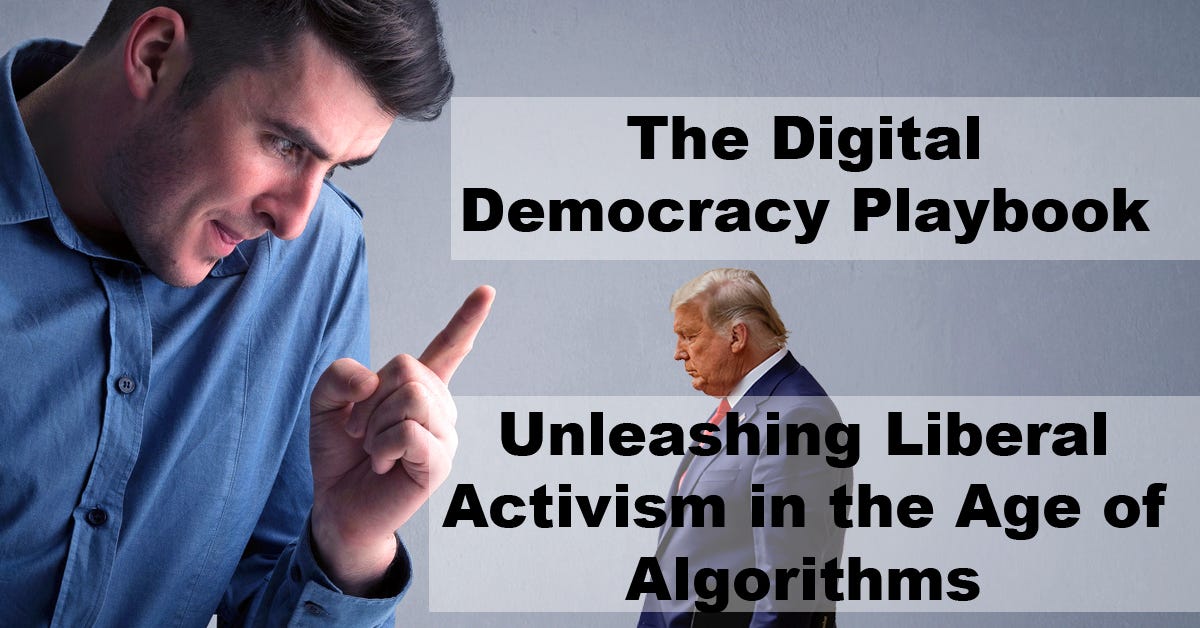How to Beat the System and Create Real Change from Your Couch
Unleashing Liberal Activism in the Age of Algorithms
The Digital Democracy Playbook
In today's hyper-connected world, political engagement has evolved far beyond traditional methods.
This comprehensive guide will equip you with cutting-edge strategies to amplify your voice, influence public opinion, and drive tangible political change - all while leveraging the power of digital platforms and emerging technologies.
1. Master the Art of Social Media Activism
Social media has become the new public square, offering unprecedented opportunities for grassroots organizing and digital activism. [1]
To make a real impact:
Craft shareable content: Create compelling, emotionally resonant posts that tell a story and inspire action. Remember, viral content often taps into shared experiences or universal emotions. [2]
Leverage platform-specific features: Each social media platform has unique strengths. Use TikTok for short, engaging videos, Instagram for visually striking infographics, and Twitter for real-time updates and discussions. [3]
Amplify marginalized voices: Use your platform to boost underrepresented perspectives, creating a more inclusive dialogue. [4]
Coordinate cross-platform campaigns: Launch synchronized efforts across multiple platforms to maximize reach and engagement. [1]
2. Harness the Power of Data-Driven Activism
In the digital age, data is power. Use it wisely to optimize your efforts:
Analyze audience engagement: Use platform analytics to understand what content resonates with your audience and when they're most active. [1]
Conduct A/B testing: Experiment with different messaging, visuals, and call-to-action strategies to find what works best. [5]
Use predictive analytics: Leverage AI tools to forecast trends and tailor your campaigns accordingly. [6]
3. Build Digital Coalitions
Strength lies in numbers. Here's how to build and mobilize your digital army:
Utilize digital organizing tools: Platforms like Slack, WhatsApp, and Discord can help coordinate actions and strategy sessions in real-time. [1]
Create psychologically safe spaces: Foster environments where people feel comfortable expressing and exploring new ideas, both online and offline. [7]
Implement peer-to-peer outreach: Encourage supporters to engage their personal networks, leveraging the power of social influence. [8]
4. Leverage Emerging Technologies
Stay ahead of the curve by incorporating cutting-edge tools into your activism:
Explore AI-driven engagement: Use AI to draft compelling messages, generate political content, and even develop policy proposals. [9]
Utilize digital democracy platforms: Engage with tools like Loomio or Discourse to facilitate meaningful political participation and collaborative decision-making. [10]
Experiment with virtual reality: Create immersive experiences that allow people to "walk in someone else's shoes," fostering empathy and understanding for different perspectives.
5. Bridge the Online-Offline Divide
While digital activism is powerful, real-world action is still crucial. Here's how to integrate both:
Organize hybrid events: Use digital platforms to promote and coordinate physical gatherings, maximizing participation and impact. [11]
Create tangible outcomes: Transform online momentum into real-world results, such as policy changes or election victories. [2]
Document and share offline actions: Use social media to amplify the impact of physical protests or community initiatives, creating a feedback loop of engagement.
6. Master the Psychology of Persuasion
Understanding how minds change is key to effective activism:
Frame your message strategically: Tailor your language and approach to resonate with your target audience's values and concerns. [12]
Use emotional appeals wisely: Invoke emotions like hope or empathy, but be cautious with fear or guilt to avoid backlash. [12]
Leverage social proof: Highlight growing support for your cause to create a sense of momentum and inevitability. [7]
7. Innovate Your Outreach
Break through the noise with fresh approaches to engagement:
Create interactive content: Develop quizzes, polls, or augmented reality experiences that encourage active participation. [13]
Launch a podcast or streaming series: Dive deep into issues with long-form content that builds a committed audience over time.
Gamify activism: Create challenges or competitions that make political engagement fun and rewarding.
8. Educate and Empower
Knowledge is the foundation of effective activism:
Provide comprehensive civic education: Create easily digestible content explaining voting processes, policy issues, and civic responsibilities. [14]
Offer digital literacy training: Equip your supporters with the skills to navigate online spaces safely and effectively.
Create toolkits and resources: Develop shareable guides on everything from contacting representatives to organizing local events.
9. Embrace Continuous Learning and Adaptation
The digital landscape is ever-changing. Stay ahead by:
Monitoring emerging platforms: Be ready to pivot to new social media or communication tools as they gain popularity.
Studying successful campaigns: Analyze viral movements like #MeToo or successful political campaigns to extract replicable strategies. [2][15]
Fostering a culture of experimentation: Encourage your team or community to try new approaches and learn from both successes and failures.
Conclusion
By implementing these strategies, you'll be well-equipped to navigate the complex world of digital activism and make a real impact on the issues that matter most.
Remember, the most successful movements are those that adapt, innovate, and persistently push for change. Now go forth and hack the system - your digital democracy awaits!
Stay informed and inspired—join my Substack community today!
Paid subscribers receive weekly eBooks that dive deeper into select topics.
Footnotes:
https://qomon.com/blog/how-digital-tools-influence-grassroots-activism
https://medium.com/@kmthomson.11/social-media-activism-and-the-metoo-movement-166f452d7fd2
https://digitalwellnesslab.org/research-briefs/advocacy-and-activism-online/
https://www.technologyreview.com/2023/07/28/1076756/six-ways-that-ai-could-change-politics/
https://www.nesta.org.uk/report/digital-democracy-the-tools-transforming-political-engagement/
https://www.plannthat.com/successful-social-media-campaigns/
https://callhub.io/blog/political-campaign/political-marketing/










